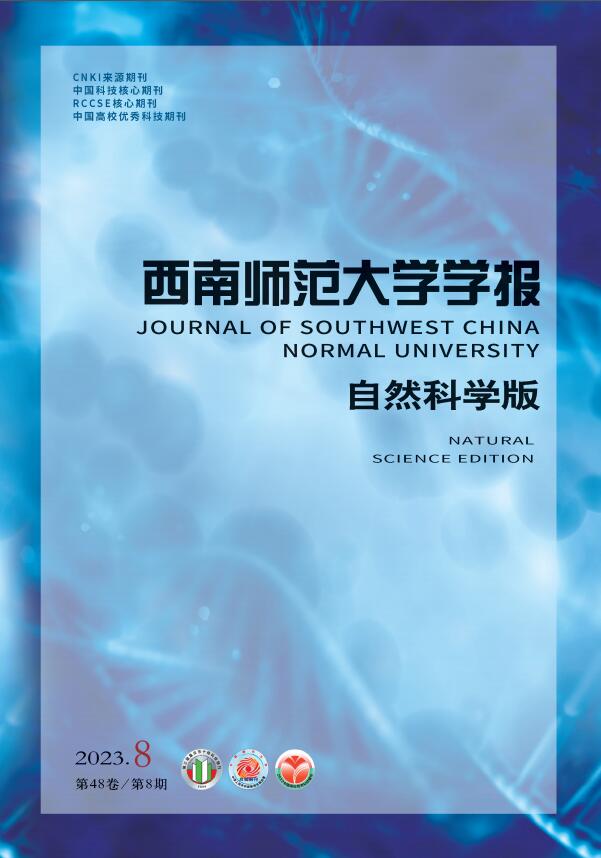-
线性正则变换[1-3]是一种比较新颖的、功能强大的信号处理工具,因其有3个自由参数,使得线性正则变换具有更多的灵活性. 傅里叶变换[4]、分数阶傅里叶变换[5]、菲涅耳变换[6]都是线性正则变换的特殊情形. 近年来,线性正则变换在解决光学系统、滤波器设计、时频分析等方面都有重要的应用[7-10].
小波变换在信号处理领域是重要的时频分析工具,在时频域分析、表征图像边缘检测、图像处理、全聚焦图像生成等方面有广泛的应用[11-13]. 近年来,小波变换在信号处理中的理论与应用也逐渐引起国内外学者的重视.文献[14]推导出了小波变换的卷积和相关定理,表明其在时频上具有相似性,并且证明了卷积定理对加噪信号恢复的有效性. 文献[15]利用一种新型卷积,给出了均匀采样和低通重构公式. 文献[16]提出了广义小波变换的卷积定理. 文献[17]提出了分数阶小波变换的卷积和相关定理. 文献[18]研究了小波的希尔伯特变换,得到了更高的消失矩. 由于线性正则小波变换是分数阶傅里叶小波变换的进一步拓展,可以实现对信号在时间线性正则域的多分辨率分析,因此在信号处理中有着非常重要的作用.
本文在线性正则变换与小波变换的基础上,首先给出了线性正则小波函数的容许性条件与正则性条件,其次研究了一类新型线性正则小波卷积与相关定理,最后利用所得定理,研究了线性正则小波域的滤波设计.
HTML
-
定义1[3] 函数f(x)的线性正则变换定义为
其中,核函数为
M=(A,B,C,D)为参数矩阵,A,B,C,D∈
$ \mathbb{R}$ ,且满足AD-BC=1.线性正则变换的逆变换表示为
其中,参数矩阵M-1=(D,-B,-C,A).
当参数矩阵M=(0,1,-1,0)时,线性正则变换退化为经典的傅里叶变换
性质1(叠加性)
$L^{\left(A_2, B_2, C_2, D_2\right)}\left(L^{\left(A_1, B_1, C_1, D_1\right)}(f(x))\right)=L^{(E, F, G, H)}(f(x)) $ .性质2(可逆性)
$L^{(D, -B, -C, A)}\left(L^{(A, B, C, D)}(f(x))\right)=f(x) $ .定义2 设
$f \in L^2 { (\mathbb{R}) } $ ,小波函数$\psi \in L^2({ \mathbb{R} }) $ ,且满足可容许性条件则f的小波变换定义为
其中,小波基函数定义为
$a \in \mathbb{R}_{+}, b \in \mathbb{R} $ 分别代表尺度和平移参数. 小波变换的逆变换为定义3[16] 线性正则小波变换定义为
这里的ψM,a,b(x)为核函数,满足
它的逆变换定义为
当M=(cos θ,sin θ,-sin θ,cos θ)时,线性正则小波变换退化为分数阶小波变换
定义4[19] 线性正则变换的卷积运算定义为
当参数矩阵M=(0,1,-1,0)时,线性正则卷积运算退化为经典的卷积运算
基于传统的卷积算子,新的卷积运算可以由经典卷积运算表示为
定义5[14] 设f和g是定义在
$\mathbb{R}^2 $ 上的复值函数,则仅有一个变量的卷积运算分别定义为定义6[19] 线性正则变换的相关运算定义为
当参数矩阵M=(0,1,-1,0)时,线性正则变换的相关运算退化为
定义7[14] 如果f和g是定义在
$\mathbb{R}^2 $ 上的复值函数,仅有一个变量的相关形式分别为定义8[14] 给定函数
$f \in L^2(\mathbb{R}), h \in L^2\left(\mathbb{R}^2\right) $ ,它们的广义卷积定义为引理1[14] 设
$\psi_f \in L^2(\mathbb{R}) \text { 和 } \psi_h \in L^1(\mathbb{R}) \cap L^2(\mathbb{R}) $ 是两个容许性小波,令$W_f^{\psi_f}, W_h^{\psi_h} $ 分别表示函数$f \in L^2(\mathbb{R}), h \in L^1(\mathbb{R}) \cap L^2(\mathbb{R}) $ 具有母小波ψf,ψh的小波变换,如果$g=(f * h), \psi_g=\left(\psi_f * \psi_h\right) $ ,那么就有引理2[17] 设
$\psi_f \in L^2(\mathbb{R}) \text { 和 } \psi_h \in L^1(\mathbb{R}) \cap L^2 { (\mathbb{R}) } $ 是两个容许性小波,令$W_{f, \alpha}^{\psi_f}, W_{h, \alpha}^{\psi_h} $ 分别表示函数$f \in {L^2}(\mathbb{R}), h \in {L^1}(\mathbb{R}) \cap {L^2}{\rm{ (}}\mathbb{R}{\rm{)}} $ 具有母小波ψf,ψh的分数阶小波变换,如果$g=(f * h), \psi_g=\left(\psi_f * \psi_h\right) $ ,那么就有引理3[14] 设
$\psi_f \in L^2(\mathbb{R}), \psi_h \in L^1(\mathbb{R}) \cap L^2(\mathbb{R}) $ 是两个容许性小波,令$W_f^{\psi_f}, W_h^{\psi_h} $ 分别表示函数$f \in L^2 { (\mathbb{R}) }, h \in L^1 { (\mathbb{R}) } \cap L^2 { (\mathbb{R}) } $ 具有母小波ψf,ψh的小波变换,如果$g=(f \odot h), \psi_g=\left(\psi_f \odot \psi_h\right) $ ,那么就有引理4[17] 设
$\psi_f \in L^2(\mathbb{R}), \psi_h \in L^1(\mathbb{R}) \cap L^2(\mathbb{R}) $ 是两个容许性小波,令$W_{f, \alpha}^{\psi_f}, W_{h, \alpha}^{\psi_h} $ 分别表示函数$f \in L^2 { (\mathbb{R}) }, h \in L^1 { (\mathbb{R}) } \cap L^2 { (\mathbb{R}) } $ 具有母小波ψf,ψh的分数阶小波变换,如果$g=(f \odot h), \psi_g=\left(\psi_f \odot \psi_h\right) $ 那么就有定义9[14] 设
$\psi \in L^2(\mathbb{R}) $ 为容许性小波,且有0≤ρ < N,若则称Mψρ为小波函数ψ的N阶消失矩.
引理5[14] 设
$\psi_f \in L^2(\mathbb{R}), \psi_h \in L^1(\mathbb{R}) \cap L^2(\mathbb{R}) $ 是两个具有N1和N2阶消失矩的容许性小波,令$\psi_p=\left(\psi_f * \psi_h\right) \text { 和 } \psi_q=\left(\psi_f \odot \psi_h\right) $ ,则ψp,ψq也是可容许性小波并且具有Nf+Nh阶消失矩.
-
定理1 设
$\psi_f \in L^2(\mathbb{R}) \text { 和 } \psi_h \in L^1 { (\mathbb{R}) } \cap L^2 { (\mathbb{R}) } $ 是两个具有N1和N2阶消失矩的容许性小波,设${\psi _p} = \left( {{\psi _f}\mathop \otimes \limits^A {\psi _h}} \right), {\psi _q} = \left( {{\psi _f}\mathop \odot \limits^A {\psi _h}} \right) $ ,则ψp,ψq也是可容许性小波并且具有Nf+Nh阶消失矩.证 由于
$\psi_f \in L^2(\mathbb{R}), \psi_h \in L^1(\mathbb{R}) \cap L^2(\mathbb{R}) $ ,可知$\psi_p, \psi_q \in L^2(\mathbb{R}) $ ,且有因为ψf和ψh是容许性小波,根据(1)式知道0 < ψf,ψh < ∞,根据线性正则变换的性质,得到
则可以得到
因此,我们得出
因为
$\psi_h \in L^1(\mathbb{R}) $ ,则$L_{{\psi _h}}^\mathit{\boldsymbol{M}}(w) $ 有界,因此存在正实数K,使得$\left| {L_{{\psi _h}}^\mathit{\boldsymbol{M}}(w)} \right| \le K $ ,由线性正则变换与傅里叶变换的关系可得其中
$\psi_h=\exp \left(\frac{j A x^2}{2 B}\right) \psi_f $ . 因此小波ψp和ψq满足容许性条件.下面考虑ψp的ρ阶矩
由定义4可得
其中
令ρ≤Nf+Nh,若k≤Nf,则有
$ \boldsymbol{M}_{\psi_f}^k=0$ ,进而可得$\boldsymbol{M}_{\psi_f^*}^k=0 $ ,即有$ \boldsymbol{M}_{\psi_p}^\rho=0$ . 若ρ-k≤Nh,则有$\boldsymbol{M}_{\psi_h}^{\rho-k}=0 $ ,进而可得$\boldsymbol{M}_{\psi_h^*}^{\rho-k}=0 $ ,即$ \boldsymbol{M}_{\psi_p}^\rho=0$ . 因此ψp具有Nf+Nh阶消失矩. 同理可证ψq具有Nf+Nh阶消失矩,证毕.定理2 设
$\psi_f \in L^2 { (\mathbb{R}) 和 } \psi_h \in L^1 { (\mathbb{R}) } \cap L^2 { (\mathbb{R}) } $ 是两个容许性小波,令$W_{f, \boldsymbol{M}}^{\psi_f}, W_{h, \boldsymbol{M}}^{\psi_h} $ 分别表示函数$f \in L^2(\mathbb{R}), h \in L^1(\mathbb{R}) \cap L^2(\mathbb{R}) $ 具有母小波ψf,ψh的线性正则小波变换,如果则有
证 g(x)的线性正则小波可以写为
其中
将
$g(x), \psi_g\left(\frac{x-b}{a}\right) $ 带入$W_{g, \boldsymbol{M}}^{\psi_g}(a, b) $ 中,得到令
$\alpha=x-\tau, \beta=b+a y-\tau $ ,且满足$\beta^2-b \beta=\frac{y(x-b)}{a}-\tau y $ ,即定理3 设
$\psi_f \in L^2(\mathbb{R}) \text { 和 } \psi_h \in L^1 { (\mathbb{R}) } \cap L^2 { (\mathbb{R}) } $ 是两个容许性小波,令$W_{f, \boldsymbol{M}}^{\psi_f}, W_{h, \boldsymbol{M}}^{\psi_h} $ 分别表示函数$ f \in {L^2}(\mathbb{R}), h \in {L^1}{(\mathbb{R}) } \cap {L^2}{ (\mathbb{R})}$ 具有母小波ψf,ψh的线性正则小波变换,如果则有
证 g(x)的线性正则小波可以写为
其中
将
$g(x), \psi_g\left(\frac{x-b}{a}\right) $ 带入$ W_{g, \boldsymbol{M}}^{\psi_g}(a, b)$ 中,得到令
$\alpha=\tau-x, \beta=\tau-b-a y, \gamma=\tau x-b^2+2 b $ ,且满足注1 定理1与定理3表明,线性正则小波卷积运算与相关运算在每个尺度上是独立的,结合线性正则小波变换可以在时频域联合表征信号特性,我们可以对给定的信号的不同尺度构造相应的空变滤波.
注2 这些定理表明,两个信号卷积的联合时频表征可以表示为两个信号在每个固定频率上的联合时频表征在时间变量或空间变量上的卷积.
由于联合时频表征的空变滤波不同于傅里叶域的时不变滤波,因此我们可以通过以下步骤实现时变或者空变滤波:
步骤1 给信号f(x)做线性正则小波变换
$W_\boldsymbol{M}^\psi(a, b) $ ;步骤2
$W_\boldsymbol{M}^\psi(a, b) $ 乘传递函数T(a,b);步骤3 给
$W_\boldsymbol{M}^\psi(a, b) T(a, b) $ 做逆线性正则小波变换.空变滤波的实现如图 1所示:
下面我们给出具体分析:
设
$ f(x) \in L^2(\mathbb{R}), \psi_1, \psi_2 \in L^1(\mathbb{R}) \cap L^2(\mathbb{R}), T(a, b) \in L^2\left(\mathbb{R}^2\right), W_\boldsymbol{M}^{\psi_1}(a, b)$ 表示信号f(x)的具有小波函数ψ1的线性正则小波变换,对(2)式做逆线性正则小波变换,可得
令
则可得线性正则小波变换域空变滤波
-
本文在线性正则变换与小波变换卷积的基础上,研究了一类新型线性正则小波变换的卷积定理与相关定理. 首先给出了线性正则小波卷积和相关的容许性条件与正则条件;其次推导出线性正则小波变换的卷积定理;最后,利用所得卷积及其卷积定理,研究了线性正则小波变换域的滤波设计,给出了线性正则小波域的空变滤波的设计方法.







 DownLoad:
DownLoad: